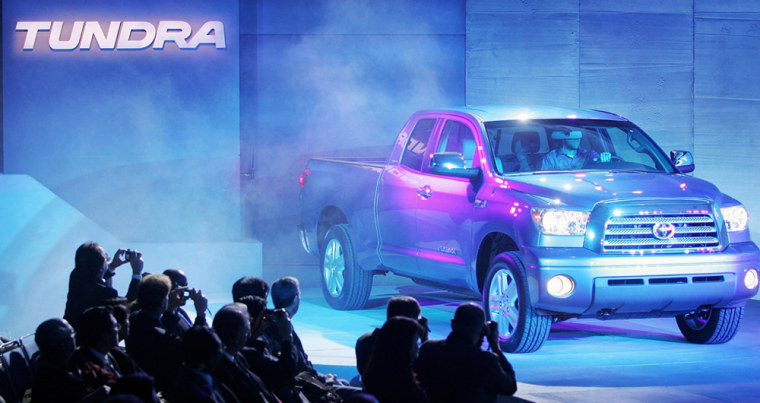Indiana-born rock star John Mellencamp may not be the first person that springs to mind when it comes to pickup trucks, but with sales slipping, automakers are painting themselves red, white and blue to capture customers in America’s heartland.
General Motors has hired Mellencamp to record a patriotic tune called “Our Country” for its Chevy Silverado television commercials. “This is our country; this is our truck,” a narrator says in the commercial.
The strategy may seem tacky, but it’s part of a big battle brewing in the automotive business over pickup sales, which are down from 10 to 15 percent this year for the Big Three automakers. And ground zero for that battle is America’s heartland.
Ford and GM’s Chevy division dominate U.S. truck sales, but now Japan’s Toyota is aiming to muscle its way into the American market with its 2007 Tundra truck. The full-size pickup, which was introduced in 1999 and will be relaunched soon with an all-new version, goes up against Chevy’s Silverado, the Dodge Ram and Ford’s F-Series pickup, long the country’s best-selling vehicle and Ford’s bread-and-butter product.
Toyota wants to convince American truck drivers to trade in their U.S.-made vehicles for Japanese Tundras, but with an American twist. The company is preparing to move production of the Tundra to a new plant in Texas, the nation’s biggest pickup market, where one of every four vehicles sold is a pickup, compared with one in every eight elsewhere in the United States.
“Toyota has been expanding by building more plants in North America — they put them in areas where they want to increase their business,” said George Magliano, director of automotive industry research at Global Insight. “The idea is truck buyers become more loyal to a manufacturer that brings jobs and money into their state."
The truck segment is a missing piece in Toyota’s product line-up, which focuses on sedans and also includes smaller crossover vehicles. Toyota is looking to grow and break into new vehicle markets, said Magliano. The American pickup market, which has largely been the domain of the Big Three until now, is very lucrative and a tough one to crack, he added.
“One strength Toyota has is its ability to stick with a strategy,” said Magliano. “They got into the truck market about 10 years ago, and they didn’t have much success right away, but they just kept working at it. They keep on improving a product, and they eventually crack the market and that is how they are gaining market share in the United States.”
Indeed, the new 2007 Tundra is much larger and more powerful than its predecessor, with a reported 5.7-liter, 381-horsepower V-8 engine, compared with the old 271 horses. Trucks start rolling off the San Antonio assembly line next month and hit the showrooms early next year.
GM and Ford are not taking Toyota’s assault on their turf lying down. At last month’s State Fair of Texas, Ford showed off its latest F-Series pickups, while GM unveiled a redesigned Silverado and the GMC Sierra HD. The Silverado is the No. 2 seller, but sales are down 15 percent from last year, according to research by Autodata, which tracks the industry.
It is no mistake that all the players chose to focus heavy marketing efforts on the Texas fair.
“[Texas] is ground zero for truck leadership,” Mark Fields, Ford’s president of the Americas told The Associated Press. “If you don’t show up in Texas, particularly at a venue like the state fair, you might as well not show up at all. This is where you duke it out. It’s where you make your bones as far as burnishing truck production.”
Toyota’s Tundra play is part of a broader strategy to win over middle America. Earlier this year Toyota announced it plans to become the first foreign manufacturer since the 1950s to supply cars for NASCAR’s top series, entering a Camry — the nation’s best-selling car — in the NASCAR Nextel Cup and Busch series in 2007.
NASCAR is a uniquely American sport, and Toyota wants to be associated with it. The reason is pure demographics. Working-class NASCAR fans, who mainly live in the center of the country, tend to be loyal to GM, Ford and Chrysler. Foreign brands like BMWs, Toyotas and Hondas are generally more popular in coastal markets.
It remains to be seen whether Toyota can persuade drivers outside America’s heartland to switch to the Tundra. Higher gasoline prices this summer pushed more consumers toward smaller, more fuel-efficient cars. U.S. truck sales, which totaled about 2.5 million units last year, will drop to about 2.3 million in 2006, said Magliano.
Magliano expects truck sales to hold steady in the 2.4 million-unit range. Pickup trucks are still vital for those working in construction or manufacturing, and so purchases from that sector should keep sales afloat, he added.
“And the Big Three have loyal customers,” Magliano said. “Chevy sells about 1 million Silverados a year and Ford is not far behind with the F-Series. So it’s tough to crack this market. They have loyal customers and they tend to keep them for life.”
